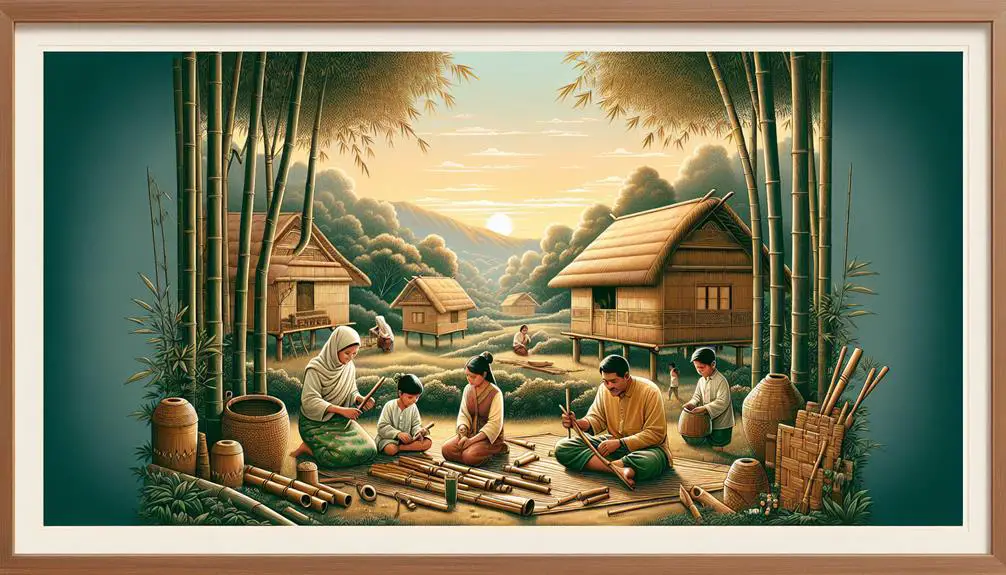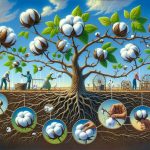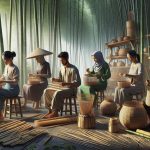Bamboo holds a special place in my Filipino heritage. It's not just a plant; it's a symbol of resilience and strength, deeply embedded in our daily life and traditions. We use it everywhere – from the music at our festivals, where bamboo flutes echo, to the sturdy yet graceful Bahay Kubo homes that dot our landscapes. It also stars in many of our ceremonies, ensuring our connection to our ancestors stays strong. Economically and environmentally, it's a superstar too, boosting our economy while keeping our air clean and our soil sturdy. There's so much more to uncover about how bamboo shapes our lives.
Table of Contents
Key Takeaways
- Bamboo symbolizes resilience and strength, aligning with Filipino values of harmony with nature.
- It is integral to rituals, festivals, and traditional Filipino homes like the Bahay Kubo.
- Bamboo usage in tools, instruments, and furniture reflects its deep-rooted presence in daily Filipino life.
- Economically, bamboo supports local livelihoods and contributes to the Philippines' economy through exports.
- Environmentally, it aids in soil stabilization, carbon dioxide absorption, and reforestation efforts.
Symbolism in Filipino Culture
Bamboo holds a special place in Filipino culture, symbolizing our resilience and strength. It's not just another plant; it's a cornerstone of our heritage and a testament to our ability to adapt and thrive in any situation. This symbolism is deeply woven into many facets of our lives, especially in how we build our homes.
Using bamboo in housing isn't just a nod to tradition; it reflects a commitment to sustainability and eco-friendliness. Bamboo grows quickly, making it an ideal renewable resource compared to traditional timber. Plus, its natural properties make it incredibly resilient and flexible, perfect for withstanding the tropical storms that often hit our islands.
Incorporating bamboo into our homes goes beyond practicality. It's a matter of pride and a connection to our ancestors who mastered the art of bamboo craftsmanship long before modern building materials were available. By choosing bamboo housing, we're not just building homes; we're preserving a piece of our identity and passing on the values of harmony with nature and resourcefulness to future generations.
It's clear why bamboo is more than just a plant in the Philippines—it's a symbol of our enduring spirit and ingenuity.
Bamboo in Daily Life
We've seen how bamboo shapes our homes and culture, but let's explore how it weaves into our everyday activities. From the moment I wake up, bamboo is part of my life. It's in the bamboo furniture that decorates our living space—chairs, tables, and even bed frames crafted from this versatile material. Not only do they look unique, but they're incredibly durable and eco-friendly too.
In the kitchen, bamboo rules. We've got utensils like spoons and forks, and even cooking instruments made from bamboo. They're perfect for handling our local dishes, which require lots of stirring and flipping. Plus, bamboo doesn't conduct heat, which means no more burnt fingers!
Heading out to the fields, bamboo continues to be indispensable. It's used for making tools and even structures like the Bahay Kubo, a traditional Filipino house, providing shelter and a cool environment. And let's not forget music. Bamboo flutes and drums add a rich, organic sound to our cultural celebrations, connecting us more deeply with our heritage.
Everywhere I look, bamboo's there, making life easier and keeping our traditions alive. It's not just a plant; it's a vital part of our Filipino way of life.
Environmental Benefits
Aside from its daily uses, bamboo significantly boosts our environment's health. Let's dig into the environmental benefits of this amazing plant.
First off, did you know bamboo produces 35% more oxygen than trees? That's a huge win for our air quality! Plus, it absorbs up to 12 tons of carbon dioxide per hectare every year. That's like taking a bunch of cars off the road when it comes to reducing greenhouse gases.
But it doesn't stop there. Bamboo's root system is a real hero in preventing soil erosion and flooding. This network keeps the soil in place, making it an essential player in soil conservation. After events like the Hiroshima atomic blast, bamboo was one of the few things that stood tall and resilient. This toughness helps it survive in harsh conditions and bounce back quickly.
Moreover, bamboo plays a critical role in repairing soil that's been damaged by overgrazing or poor farming practices. It helps bring back nutrients and improves soil structure, which promotes healthier ecosystems overall. So, bamboo isn't just about cultural significance; it's a powerhouse in sustaining our environment too.
Cultural Traditions
Let's explore how bamboo is more than just a plant in Filipino culture; it's a cornerstone of many traditions.
From rituals that weave the community together to the beautiful sounds of bamboo musical instruments, it's clear bamboo shapes much of the cultural landscape.
We'll also look at how artists use bamboo to express their creativity in various forms.
Bamboo in Filipino Rituals
Bamboo holds a crucial role in Filipino rituals, symbolizing unity, spirituality, and practicality across various cultural traditions. It's fascinating to see how this simple plant weaves into the fabric of our lives, especially during significant events.
- Weddings: Bamboo poles are used to symbolize the strength and unity of the newlyweds. It's not just decoration; it's a profound emblem of their commitment.
- Festivals: Traditional dances are often accompanied by the rhythmic beats of bamboo drums and gongs, setting the festive atmosphere.
- Religious Ceremonies: Bamboo forms part of the altars and icons, grounding spiritual practices in nature.
- Agricultural Rituals: It's used in tools and structures, vital for farming rituals.
- Indigenous Rituals: Bamboo serves as containers and instruments, essential in the preservation of cultural heritage.
Artistic Bamboo Expressions
I've always been captivated by how bamboo isn't only a part of Filipino life but also a canvas for artistic expression. From the traditional Bahay Kubo to beautifully crafted furniture, bamboo showcases the creativity deeply rooted in our culture. Artisans transform this versatile material into elegant chairs, tables, and even intricate cabinets, each piece reflecting years of mastered skills and traditions.
During festivals, bamboo takes center stage in dances like Tinikling, where participants weave through clashing poles, mirroring the agility and rhythm innate to our heritage. Even in our kitchens, bamboo utensils and serving dishes aren't just tools but artworks, integrating practicality with artistic flair, making every meal a cultural statement.
Bamboo Musical Instruments
In our culture, bamboo isn't only used for practical items but also for crafting traditional musical instruments like flutes and drums. Here's a glimpse into how bamboo musical instruments are integral to our heritage:
- Flutes and Xylophones: Crafted from bamboo, these instruments produce melodious sounds that are essential during festivals and communal gatherings.
- Drums and Gongs: These provide the rhythmic backbone to many traditional dances and ceremonies.
- Unique Sound Qualities: Bamboo's natural resonance enhances the music, creating a distinct sound that's deeply rooted in our cultural expression.
- Heritage and Craftsmanship: The knowledge of making these instruments is passed down through generations, preserving our rich cultural history.
- Versatility: Bamboo's adaptability allows for various instrument designs, showcasing Filipino ingenuity.
Bamboo in Filipino Art
In the realm of Filipino art, bamboo isn't just a material; it's a source of inspiration and innovation.
From traditional crafts like baskets and mats to the creation of unique bamboo musical instruments, artists showcase their skill and cultural heritage.
Contemporary bamboo artistry further explores this versatility, blending modern techniques with ancient themes.
Traditional Bamboo Crafts
Bamboo crafts are a vibrant part of Filipino art, with locals turning this flexible material into everything from musical instruments to traditional homes. The expertise in bamboo craftsmanship is truly impressive, showcasing a deep cultural heritage and practical ingenuity.
- Weaving Techniques: Artisans weave bamboo into intricate patterns for baskets, mats, and decorative wall hangings.
- Traditional Homes: The iconic Bahay Kubo is constructed largely from bamboo, epitomizing sustainable architecture.
- Weapons: Skillfully made bamboo spears and blowguns reflect historical and martial aspects of Filipino culture.
- Sculptures: Bamboo is intricately carved into statues and figures, often used in religious and cultural ceremonies.
- Artistic Carvings: Decorative carvings on bamboo pieces showcase unique Filipino aesthetics and craftsmanship.
Bamboo Musical Instruments
Many traditional Filipino musical instruments are crafted from bamboo, enriching the country's cultural performances with their unique sounds. The versatility of bamboo allows artisans to create flutes, xylophones, drums, and gongs, each offering distinct tones that deeply resonate during traditional Filipino music and dances.
These bamboo musical instruments aren't just tools for entertainment; they're pivotal in preserving and conveying the rich tapestry of Filipino heritage. The craftsmanship involved showcases not only creativity but also a profound respect for sustaining cultural values through art.
It's fascinating how these instruments, made from such a simple material as bamboo, can produce such a wide array of rich, captivating sounds that are integral to the authenticity of Filipino performances.
Contemporary Bamboo Artistry
Filipino artists are now turning bamboo into breathtaking sculptures, paintings, and installations that merge traditional craftsmanship with modern creativity. This blend not only honors our rich heritage but also pushes the bamboo industry forward by showcasing its potential in contemporary art.
- Sculptures that transform bamboo into fluid, dynamic forms, challenging perceptions of its rigidity.
- Paintings where bamboo is both the subject and the tool, bridging old themes and new techniques.
- Installations that interact with spaces, creating dialogues about nature and sustainability.
- Functional art pieces that demonstrate bamboo's versatility beyond aesthetic value.
- Conservation-focused pieces that advocate for environmental care, reflecting the ethos of the bamboo industry.
These artistic endeavors elevate our cultural narrative and highlight bamboo's integral role in Filipino modern artistry.
Economic Impact
Through various industries like construction, food, and furniture, bamboo significantly boosts the Philippine economy. It's not just about the products themselves but the speed at which bamboo grows. This fast growth means we can harvest bamboo much quicker, typically within 3-5 years, compared to other materials. This quick turnover is a big deal because it keeps the cash flowing and helps the economy churn faster.
Bamboo also opens up a lot of doors for export income. As the world looks for more sustainable resources, our bamboo products are in hot demand. This isn't just good for business; it's a game changer for our economic growth and sustainability. By exporting bamboo, we're not just selling a product, we're selling a piece of our sustainability efforts.
Moreover, the push to develop innovative bamboo products is creating new market opportunities abroad. This isn't just about making money; it's about setting trends in the global market, which further enhances our economic impact.
Lastly, let's not forget the local scene. Bamboo propagation boosts local economies and stabilizes community livelihoods. It's all connected, really. By supporting bamboo, we're fortifying our economic foundation from the ground up.
Construction Uses
Building on its economic value, bamboo also plays a pivotal role in Filipino construction practices. As a versatile construction material, it's deeply integrated into the very fabric of traditional and modern Filipino architecture.
Here's a quick rundown of how bamboo is used in construction:
- Traditional Homes: Bamboo is the backbone of the iconic 'Bahay Kubo', providing both structure and aesthetics.
- Educational and Public Buildings: Schools and community centers often utilize bamboo for its robustness and quick availability.
- Furniture Making: It's not just about the buildings; bamboo is also shaped into functional and stylish furniture like chairs and tables.
- Tools and Utilities: From ladders to scaffolding, bamboo's strength and flexibility make it ideal for creating construction tools.
- Fencing and Enclosures: Bamboo fences and livestock cages are common sights, blending functionality with natural beauty.
Bamboo's role as a construction material can't be overstated. It's not just about using what's available; it's about crafting spaces that are both sustainable and reflective of Filipino ingenuity. Whether it's a simple home or a more complex structure, bamboo stands at the core of construction practices in the Philippines.
Sustainability Practices
How does bamboo contribute to sustainable practices in the Philippines?
Well, it's all about its renewable nature and eco-friendly characteristics. In the Philippines, bamboo isn't just a plant; it's a powerhouse in the sustainability arena. Its cultivation plays a massive role in reforestation efforts, which are crucial given the country's vulnerability to natural disasters like typhoons and floods. By integrating bamboo into reforestation, we're not only restoring our forests but also creating a sustainable source of materials that can replace less eco-friendly options.
Moreover, bamboo's ability to grow quickly and adapt to different environments makes bamboo propagation a key strategy in these sustainability efforts. This rapid growth cycle helps in balancing the ecosystem and significantly reduces the carbon footprint, as bamboo absorbs carbon dioxide at a high rate. Promoting bamboo-based products further aids in this, pushing for a greener lifestyle and product choices.
Future Prospects
Looking ahead, the prospects for bamboo in the Philippines aren't only promising but pivotal for sustainable growth. As we dive deeper into what the future holds, it's clear that bamboo is set to play a massive role in various sectors of our economy and environmental initiatives.
Here's a quick snapshot of what's coming:
- Economic Boosts through Bamboo Propagation: With more emphasis on cultivating different bamboo species, we're looking at a surge in job opportunities and local economies thriving from bamboo-based enterprises.
- Advancements in Bamboo Products: Innovation in processing and product development is setting the stage for high-quality, competitive bamboo goods.
- Sustainable Construction Materials: The push towards eco-friendly building materials means bamboo is becoming a go-to resource, reducing our carbon footprint.
- Government Support and Investment: Increased backing from the government is speeding up research and infrastructure development, making the industry more robust.
- Expansion in Export Markets: Bamboo's potential as a key export product is being realized, opening up international trade opportunities that could redefine our economic landscape.
It's a dynamic time for the bamboo industry, and I'm all here for it. Let's keep our eyes peeled as these developments unfold!
Frequently Asked Questions
What Is the Significance of Bamboo in Philippines?
Bamboo's significance in the Philippines stretches from architecture to daily tools. It's crucial for constructing homes and crafting instruments, deeply embedding it in both practical and cultural aspects of Filipino life.
What Is the Symbol of Filipino Bamboo?
The symbol of Filipino bamboo represents resilience, strength, and versatility. It's integral in everything from housing to tools, reflecting the nation's ability to adapt and thrive in various circumstances.
What Is the Contribution of Bamboo Crafts in the Philippines?
Bamboo crafts in the Philippines preserve traditional skills, support local economies, and promote sustainability. They're passed down through generations, reflecting a rich cultural heritage and holding significant market value both locally and internationally.
What the Meaning Characteristic of the Filipinos Can Be Compared to a Bamboo?
I'd say the characteristic of Filipinos compared to bamboo is our resilience. We adapt and overcome challenges, much like bamboo bends but doesn't break under pressure, showing both strength and flexibility.
- Does Chiffon Fabric Stink - July 15, 2025
- Does Chiffon Fabric Affect the Economy - July 15, 2025
- Does Cotton Fabric Have a Nap - July 15, 2025







